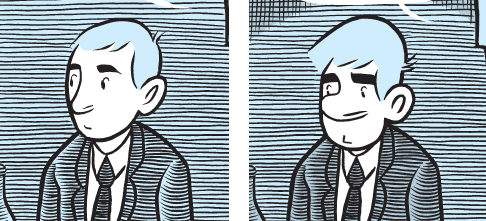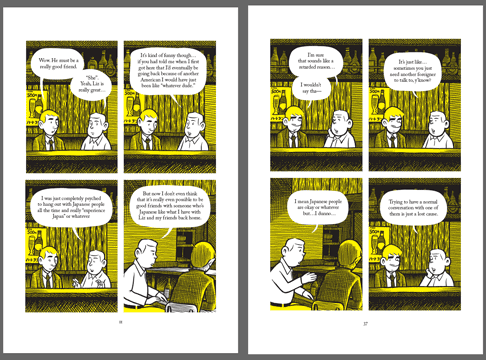
Pictured: Tonoharu’s protagonist, before and after graphical edits
This is the tenth (and final) entry in a series of posts describing my process for creating my graphic novel Tonoharu. This post deals with the “post-production” edits (for lack of a better term).
I’ve been drawing comics since I was in junior high. I’ve experimented with all sorts of formats & sizes, drawing styles & materials. Most of these experiments were dead ends, but little by little (by the process of elimination if nothing else) they helped me to realize what sort of comics I wanted to make. By the time I started working on Tonoharu in 2003, I had a fairly strong sense of what direction I wanted to go in, not only for Tonoharu, but (presumably) for the works that will follow it.
But that isn’t to say that I had all the fine details ironed out. Daydreaming and theorizing about the comics I wanted to draw only took me so far; only by committing something to paper was I able to see what worked and what didn’t in practice. For the things that didn’t work out, I did my best to make them right after the fact, via graphical and textual edits.
Editing the Pictures
When I started drawing Tonoharu, I hadn’t completely settled on what the characters would look like. For the main character in particular, I had a hard time capturing the qualities I wanted express in his face, which was unfortunate because he is in practically every panel. But as I drew him over and over, his facial features slowly evolved, and he started looking more and more as I had vaguely imagined him in my mind’s eye.
The problem was, the drawings of him from early in the book looked almost nothing like the final character design (as can be seen in the before and after shot at the beginning of this entry). I mean, I’m fine with some variance from drawing to drawing, but he looked like a completely different person.
So I ended up redrawing the faces I didn’t like, and frankensteining them into the original drawings using Photoshop. This took months and months of dedicated work, and became more encompassing as time went on. Ultimately virtually every face of every main character in Tonoharu: Part One was edited in this manner at least once, in some cases two or three times.
Okay, I’ll admit, I’m an insane perfectionist, and I got a little carried away. But I think being so nitpicky about the characters faces has given me a better understanding of how to do it the right way, and as a result I won’t need to do as much digital plastic surgery to the characters in Tonoharu: Part Two (maybe only half as much… sigh).

Pictured: A sheet of revised faces. Yes, I’m crazy.
Editing the Text
I have a tendency to be too wordy in my comics (and in my blog entries) and I’m always trying to curb that. It’s possible to make a good comic that’s wordy of course, but after a certain point it starts to resemble a picture book, or an illustrated screenplay. Comics that really play off the strengths of the medium tend to use words very economically; often with ten or less words per panel, and only rarely over fifteen. Take a look at any random Peanuts comic and see what I mean.
So as I edited the text of Tonoharu: Part One, my rule of thumb was to try to keep the number of words per panel under fifteen (or ideally, under ten). And unless I absolutely couldn’t help it, I tried not to go over twenty words per panel at absolute most. I was always looking for ways to tighten up scenes and make them less wordy. Iris Murdoch once said “To be a good writer, you have to kill your babies”, and that’s what editing the text was like for me. I would fret over every clever turn of phrase I was considering editing out, but nine times out of ten I realized the work was better in its absence, and wouldn’t dream of putting it back in once it was gone.

Pictured: The same page, before and after textual edits. I know it’s too small to read the actual words, but as you can see, the “before” version is a virtual wall of text, with the “after” version having been trimmed down considerably.
****
Well, I guess that just about wraps the Creating Tonoharu series up. There were a few other things I wanted to write about in more detail; maybe when Tonoharu: Part Two is close to being done, I’ll revisit Creating Tonoharu and fill in the blanks. But for now, I’m sick of writing about my creative process, so I’m declaring the series provisionally closed.
As such, next Friday’s entry will be about something completely different. Stay tuned.
Creating Tonoharu–#1: Laying The Groundwork
Creating Tonoharu–#2: The Idea
Creating Tonoharu #3–Writing the Script
Creating Tonoharu #4–The Design (1/3)
Creating Tonoharu #5–The Design (2/3)
Creating Tonoharu #6–The Design (3/3)
Creating Tonoharu #7–The Drawing
Creating Tonoharu #8–Inking
Creating Tonoharu #9–Computer Stuff
Creating Tonoharu #10–Final Edits
